Trout fishing is the ultimate test of an angler’s patience and finesse fishing abilities. Trout are finicky fish that are highly temperamental and picky about when and how they will feed. It’s vital that anglers choose the proper line when they’re going after trout. Too obvious of a line dramatically diminishes the chances of landing trout.
Anglers who are still fishing for trout should stick with a monofilament line between 4 and 8-pound test. Trolling anglers use 10-pound braid and a 6 to 8-pound fluorocarbon leader. Fly anglers should use a 4 or 5-weight floating line with a 3x or 4x leader. Shy fish require a lighter line.
There are many different ways to fish for trout, so it’s important to choose the proper line for the type of water you’re fishing.
Monofilament, Fluorocarbon & Braid
Generally, anglers have to choose between monofilament, fluorocarbon, and braid when fishing for trout.
Each type of line has its advantages for trout fishing, so it’s important to understand the difference between them.
1. Monofilament
Monofilament isn’t always a favorite for trout anglers because it has a large memory and doesn’t hide well in clear water.
So, if you’re using a heavy line and casting light lures, you won’t get as much distance as you would if you were using fluorocarbon. However, it’s pretty easy to use and the cheapest option on the market.
If you’re using it for trout, make sure you’re continually checking it to see if it has any abrasions or tears. It doesn’t handle continuous contact with rocks and sticks well.
Also, stick with a 6 to 8-pound test to ensure you have all the strength you need for the trout you land.
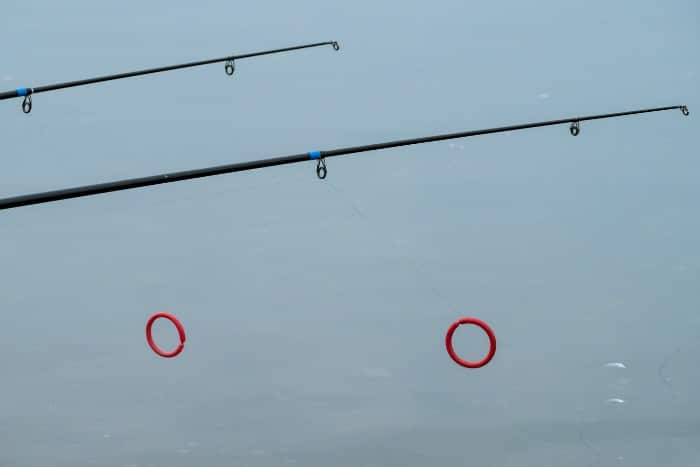
2. Fluorocarbon
Trout anglers are big fans of fluorocarbons. They are incredibly spooky fish, so the less of a footprint you have, the better.
The fish are essentially unable to see it, so it’s excellent for those clear lakes and rivers that you fish for trout.
Given the pound test you’ll use for trout, fluorocarbon can have an extremely small memory and is quite strong, so you can fish it near structure without worrying about snapping your rig.
One of the best features of fluorocarbon is that it doesn’t stretch as much as monofilament. Trout can lightly take your bait, so the minimal stretch allows for easy hook sets.
A 4 to 6-pound test fluorocarbon leader is ideal when fishing for trout.
3. Braid
Braid is the most sensitive line on the market. It has absolutely no stretch, so anglers can detect every single bite that happens.
Braid is also extremely strong, so it rarely breaks despite the amount of strain you put on it. Anglers who spend quite a bit of time trolling for trout will primarily use braid for their main line.
It cuts through the water and gets the bait down toward the bottom of the water column.
Anglers who use braid do not use it as their leader. Use braid as the main line and use a few feet of fluorocarbon as your leader.
Using braid as the main line and fluorocarbon as the leader is the perfect setup of sensitivity and power.
Trout Line To Use When Still Fishing With a Spinning Rod
When you’re using a spinning rod, you have a bit more freedom when choosing your line. Monofilament, fluorocarbon, and braid will all work, but they have their own uses in specific situations.
1. Line for Lures
When you’re throwing lures like Mepp’s and Rooster Tails (both inline spinner baits), and spoons, you need a line with a low amount of memory.
These aren’t the heaviest lures in the world, so if you’re throwing monofilament with a lure, you’ll find yourself in a bit of trouble.
You need your lures to launch off the reel, and fluorocarbon is the best option. Some anglers will use braid, but fluorocarbon is your best bet. Use anywhere between 4 and 6-pound test.
Mono with a fluorocarbon leader could work if you’re on a more budget operation.
You won’t get as long of casts as you would with just fluorocarbon, but if you’re fishing smaller bodies of water, that’s not the end of the world.
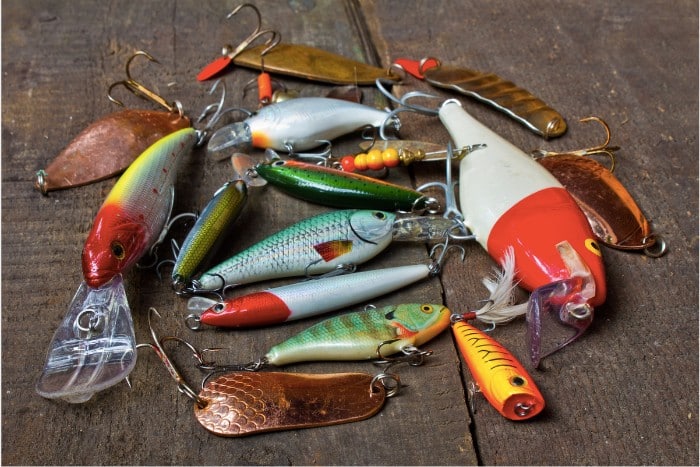
2. Line for Still Fishing
If you’re still fishing (fishing with a bobber or sinker rig), then you want a line that’s not working to pull you toward the bottom of the water.
Many anglers will use 4 to 6-pound test monofilament as their main line because it’s light and more buoyant.
The leader is extremely important on one of these rigs. Use a 4 to 6-pound fluorocarbon leader.
Fish are only going to see the bottom few feet of your setup, so the fluorocarbon is going to stay out of their way. They won’t be able to see it and will spend their entire time focusing on your bait.
The combination of your monofilament line and fluorocarbon is going to do a good job of keeping the bait suspended but still out of the way.
Trout Line To Use When Trolling
Many anglers won’t troll for any trout other than lake trout. Lake trout live in extremely deep lakes and reservoirs all over the world.
I’ve written an in-depth guide on catching lake trout if you’re into it.
Some of the most famous lake trout fishing areas are Lake Superior and Lake Michigan in the Midwest United States.
However, other places like Fort Peck in Montana have large populations of large lake trout that are best targeted via trolling.
When trolling for lake trout, anglers will use crankbaits, spoons, flies, worms, and large soft plastic minnow representations.
The most common lines used are monofilament and fluorocarbon, somewhere between 10 and 16-pound test. If your baits aren’t getting low enough in the water column, stick with fluorocarbon.
Fluorocarbon does a great job of cutting through the water due to its ability to sink, so you can always count on getting as low as needed.
Also, it’s extremely strong, so if you tie into a massive fish, you don’t have to worry about it snapping your line as soon as a laker strikes it.
Some anglers make it work with monofilament because it’s far more affordable than the other line types.
Depending on one’s budget, fluorocarbon isn’t always used when trolling because of how much line is required and how expensive it can become.
However, fluorocarbon will present bait the best out of any other option. While keeping your line hidden isn’t necessarily a priority for trolling, it certainly does not hurt.
You’re using a moving bait, so fish don’t have as much time to look and study it. Trolling strikes are more reactionary, so the privacy line choice isn’t as necessary.
Trout Line to Use for Ice Fishing
When you’re ice fishing for trout, you obviously aren’t doing any type of casting. You’re dropping your line directly into a hole and jigging your bait up and down, hoping to attract a fish.
The biggest thing to remember when you’re ice fishing for trout is how long the fish have to look at your bait. They can study it as long as they want without having to strike.
Also, your line will be exposed to cold weather and receive its fair share of abrasions as it’s falling through the hole. It needs to be strong as well as a bit flexible so the cold weather doesn’t freeze and snap.
As a result, you need fluorocarbon line when you’re ice fishing for trout. It fits the bill perfectly for ice fishing.
Many anglers will use a 4 to 6-pound test. It’s strong enough that it’ll be able to handle the majority of trout you land through the ice, but it’s not too large that it will become noticeable for trout.
Remember, they’re extremely finicky, so the more you stand out, the less chance you have of landing them. Anglers will use fluorocarbon on regular spinning reels as well as inline reels.
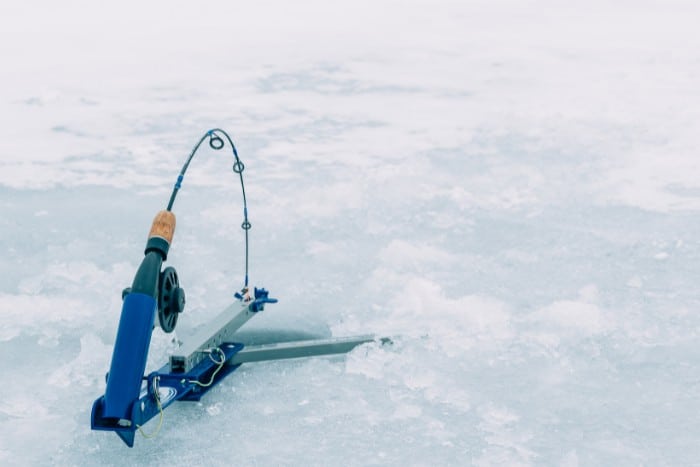
Trout Line to Use in Clear Water
Trout live in some of the clearest water in the entire world. If you’ve spent any time fishing alpine lakes high in the mountains or clear, runoff-fed streams, you know how clear the water is.
It’s not uncommon to see trout swimming throughout the lakes and rivers. If you can see the trout, they can easily see your shadow and may know you’re there.
Clear water requires fluorocarbon line. Some anglers use a clear monofilament, but it’s not possible. Plus, it requires anglers to choose a smaller pound test (2 or 4 pound).
The thin fluorocarbon can work well in small streams for small fish, but it doesn’t fit all of your needs. It can especially present issues if you find yourself tying into larger fish.
Fluorocarbon has everything you would ever need when fishing for trout in that cool, clear water.
Braid can fit the bill if you’re willing to attach a fluorocarbon leader, but it’s pretty noticeable in those gin clear conditions. Stick with the fluorocarbon!
Trout Line to Use in Dirty Water
You have much more freedom if you’re fishing for trout in stained or dirty water. You can get away with braid, monofilament as well as fluorocarbon.
A helpful thing to do when you’re fishing dirty water is to match the color of the water to your line.
Monofilament lines come in various colors, so you can find a green or brown color to match the conditions you’re fishing.
Investing in different colors of monofilament isn’t overly expensive, so it’s a smart thing to do if possible. Braid can be a good line to use in stained water.
Since you aren’t as easily able to see what’s under the water, you can find yourself getting snagged on rocks or logs.
The braid is going to give you a chance to get yourself unstuck. If you use braid, ensure you’re using a monofilament or fluorocarbon leader.
Trout will still investigate your bait if they have a chance. Also, braid isn’t overly friendly or easy to maneuver as a leader, so you’re better off choosing a different type of line.
Trout Line to Use on a Fly Rod
Fly rods are one of the most common ways anglers target trout.
They can be a bit complex when setting up, and success is heavily dependent on your setup, so make sure everything is configured correctly before you hit the water.
There are few more exciting things to do in fishing than land a trout on a fly rod. With the proper setup and some casting abilities, it doesn’t have to be overly complicated to land trout.
I’ve made the choice of setup easy peesy for you via two articles:
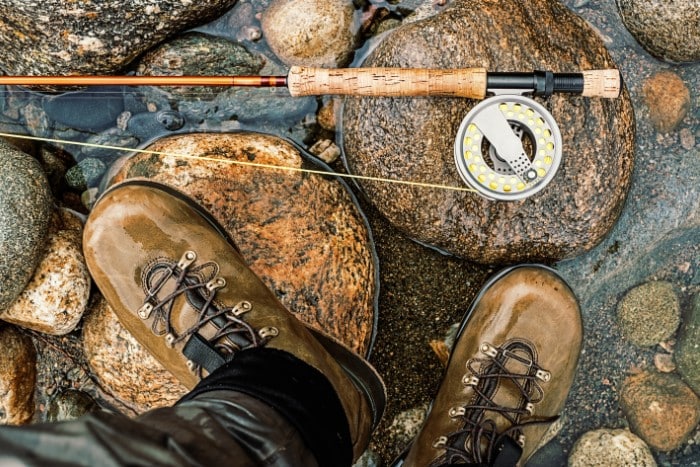
1. Backing
Your backing is the first thing that needs to be attached to your fly reel. Backing is a string-like material on your reel in case you hook into an extremely large and powerful fish.
Many anglers will put 100 or 150 yards of 15 to 20-pound backing on their reel. Using 100 to 150 yards of backing may be overkill in some situations, but it’s better to be safe than sorry.
If you hook into a fish that pulls you into your backing, you want to make sure you don’t lose it.
2. Fly Line
Your next step is to choose the fly line you want to pair with your rod and reel. Most anglers will match the weight of their fly line to the weight of their rod and reel.
For example, a 5-weight rod is a typical size for trout anglers. As a result, most anglers will use a 5-weight fly line.
After you decide on the weight, you must choose the type of fly line. If you want a versatile line, you want to use a weight-forward floating line.
The lines will allow you to cast dry flies, nymphs, and streamers. However, floating line usually works best if the water you’re fishing isn’t overly deep.
Your 7-foot to 9-foot leader is all you’ll have to get you lower in the water column. If you need to get deeper, anglers will use a sink tip line.
Sink tip lines drop a few inches in the water column to allow your heavier flies to get down towards the bottom. These are common types of lines to use for anglers who fish in lakes or extremely deep rivers.
3. Leader
The leader is one of the most essential parts of a fly fishing setup. For anglers who are primarily fishing with streamers (heavy, diving flies), a 0x or 1x 7-9 foot fluorocarbon leader is ideal.
It’s not too long and is plenty strong in case a large trout attacks.
For anglers who are fishing with nymphs or dry flies, a 3x or 4x 9-foot to 11-foot fluorocarbon leader will do the job. They’re light enough not to gain the attention of the fish.
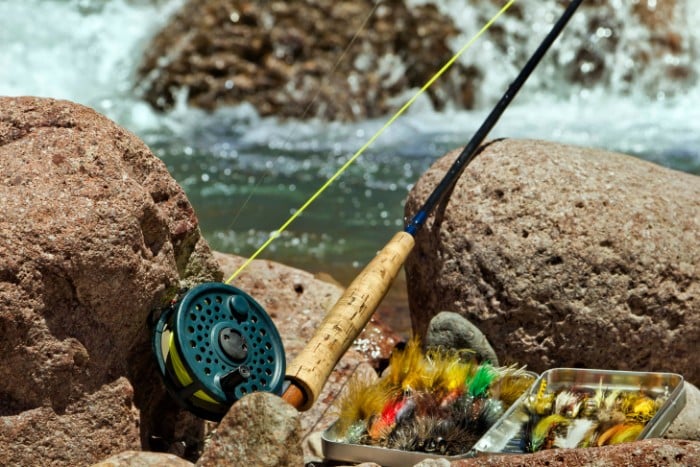
4. Tippet
Anglers who spend quite a bit of time fishing with nymphs and dry flies are familiar with tippet. Tippet is an even lighter fluorocarbon than leaders. For those extremely clear waters and spooky fish, it’s necessary.
Anglers will pair a 3x leader with 18 to 24 inches of 4x or 5x tippet. It’s somewhat challenging to get used to tying, but it can be greatly beneficial when fishing those clear waters.
Conclusion
Trout are one of the most fun fish an angler can catch. They’re powerful, aggressive, and challenging to land.
Anglers have to be aware of their primary feeding times and do a good job of using bait that they want to eat. However, success can be hard to find without the correct line type.
Remember, fluorocarbon line is clear, strong, and generally the best kind of line to use when fishing for trout.
Braid and monofilament can work, but they have to be used in stained water or paired with fluorocarbon line as the leader.
